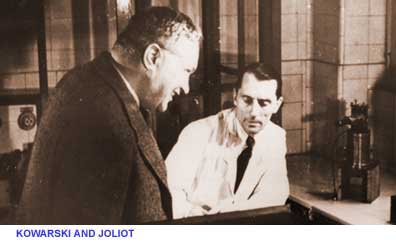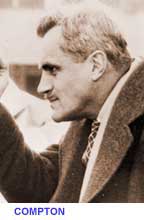
KOWARSKI: I went home for lunch. And here is one of those classical cases when scientists describe how they got ideas. I perfectly remember which place on what street it was that I had the idea. The idea seemed so stupidly simple. If you observe any neutrons of higher energy, that proves it. It's rather elementary.
The Paris and New York teams both found that neutrons do come out from split uranium atoms. Yes, a chain reaction was possible. Now the basic nuclear physics was in hand, and people could begin to ponder what to do with it. Over three years later, beneath the bleachers of the football stadium at the University of Chicago, Fermi led a team of physicists who released the first chain reaction. The physicist in charge at Chicago was Arthur Holly Compton. Here is his description of this historical moment...
 COMPTON: We entered the balcony at one end of the room. On the balcony a dozen scientists
were watching the instruments and handling the controls. Across the room
was a large cubical pile of graphite and uranium blocks in which we hoped
the atomic chain reaction would develop. Inserted into openings in this
pile of blocks were control and safety rods. After a few preliminary tests,
Fermi gave the order to withdraw the control rod another foot. We knew that
that was going to be the real test. The geiger counters registering the
neutrons from the reactor began to click faster and faster till their sound
became a rattle. The reaction grew until there might be danger from the
radiation up on the platform where we were standing. "Throw in the
safety rods," came Fermi's order. The rattle of the counters fell to
a slow series of clicks. For the first time, atomic power had been released.
It had been controlled and stopped. Somebody handed Fermi a bottle of Italian
wine and a little cheer went up. One of the things that I shall not forget
is the expressions on the faces of some of the men. There was Fermi's face—one
saw in him no sign of elation. The experiment had worked just as he had
expected and that was that. But I remember best of all the face of Crawford
Greenewalt. His eyes were shining. He had seen a miracle, and a miracle
it was indeed. The dawn of a new age. As we walked back across the campus,
he talked of his vision: endless supplies of power to turn the wheels of
industry, new research techniques that would enrich the life of man, vast
new possibilities yet hidden.
COMPTON: We entered the balcony at one end of the room. On the balcony a dozen scientists
were watching the instruments and handling the controls. Across the room
was a large cubical pile of graphite and uranium blocks in which we hoped
the atomic chain reaction would develop. Inserted into openings in this
pile of blocks were control and safety rods. After a few preliminary tests,
Fermi gave the order to withdraw the control rod another foot. We knew that
that was going to be the real test. The geiger counters registering the
neutrons from the reactor began to click faster and faster till their sound
became a rattle. The reaction grew until there might be danger from the
radiation up on the platform where we were standing. "Throw in the
safety rods," came Fermi's order. The rattle of the counters fell to
a slow series of clicks. For the first time, atomic power had been released.
It had been controlled and stopped. Somebody handed Fermi a bottle of Italian
wine and a little cheer went up. One of the things that I shall not forget
is the expressions on the faces of some of the men. There was Fermi's face—one
saw in him no sign of elation. The experiment had worked just as he had
expected and that was that. But I remember best of all the face of Crawford
Greenewalt. His eyes were shining. He had seen a miracle, and a miracle
it was indeed. The dawn of a new age. As we walked back across the campus,
he talked of his vision: endless supplies of power to turn the wheels of
industry, new research techniques that would enrich the life of man, vast
new possibilities yet hidden.
